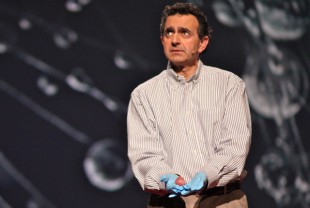Rice tissue-engineering course marks 20th anniversary
What if preparing a new organ for transplant were as simple as printing this story? That may sound like science fiction, but it’s happening today, and it’s one of the advances in regenerative medicine that is under discussion this week at Rice University’s 20th annual Advances in Tissue Engineering (ATE) short course.
In his keynote address Wednesday at Rice’s BioScience Research Collaborative, ATE speaker Anthony Atala, chair of the Department of Urology at Wake Forest Baptist Medical Center, showed a brief video of an organ being printed in his lab.
“This is basically a two-chamber heart, and we were able to print this one layer at a time using a very primitive desktop inkjet printer,” Atala said. “Instead of using ink, we printed with cells. We were able to modify this printer with a 3-D elevator so that it dropped down each time the printer went by.”

In 2011, Wake Forest researcher Anthony Atala displayed a "printed" kidney at the TED conference. The kidney was created one layer at a time by a printer that sprayed living cells instead of ink.
Moving on to the next video clip in his presentation, Atala showed a close-up of the printed heart, and said, “Here you can see that 4-6 hours later the (heart cells) are beating together.”
Atala and more than three dozen experts gathered to share their expertise at ATE, a five-day course that offers graduate students, clinicians, venture capitalists and others a comprehensive overview of the current state of research in tissue engineering and regenerative medicine. The annual course has been organized for 20 years by Rice’s Antonios Mikos, the Louis Calder Professor of Bioengineering, professor in chemical and biomolecular engineering and director of Rice’s Center for Excellence in Tissue Engineering.
In his keynote, Atala said tissue engineering is increasingly important because the number of patients awaiting organ transplants has doubled in the past 10 years and the shortage of transplantable organs will get more severe as populations age. He said the earliest tissue-engineering research was done in the 1930s, but the field came of age over the past two decades, thanks to new methods for culturing human cells and the advent of sophisticated biomaterials.
Atala began transplanting engineered bladders into patients 14 years ago, and he described subsequent work aimed at growing solid organs, including kidneys and livers. In addition to organ printing, his team has pioneered ways to use both biomaterials and donor tissues as templates for growing new organs with a patient’s own cells.
Atala said today’s clinical successes in regenerative medicine are a direct result of the work of dozens of pioneers, including Mikos and several of the other speakers at ATE. He said difficult technical hurdles remain. For example, scientists still cannot culture some types of human cells — notably liver, pancreas and nerve cells — and researchers still have difficulty growing the necessary blood vessels to keep solid organs and tissues alive.
“We still have so many challenges in the field, but one thing is certain; Regenerative medicine technologies do have the potential to make patients better,” Atala said. “So for us, it’s not about the cells we use or the materials we choose, but how those are going to make our patients better.”
For more information about ATE, visit http://tissue.rice.edu.
To see a video of Atala’s 2011 TED presentation, visit http://www.ted.com/talks/anthony_atala_printing_a_human_kidney.html.


Leave a Reply